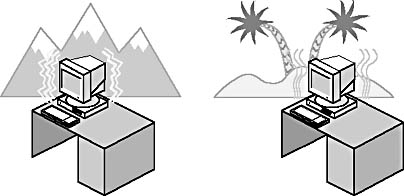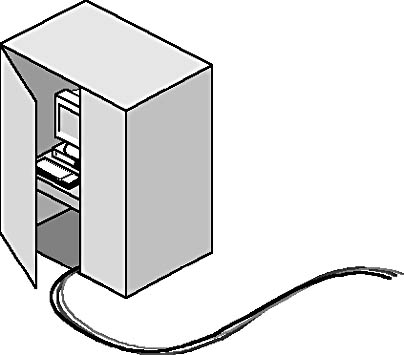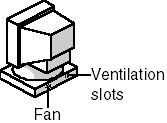Lesson 2: Maintaining a Healthy Network Environment
The physical environment in which a network resides is an important factor to consider in keeping a computer network physically secure. This lesson explores this frequently overlooked aspect of network management: ensuring a safe environment for computers, peripherals, and the associated network, and looks at what you can do to maintain the health of your network environment.
After this lesson, you will be able to:
- Describe the impact of environmental conditions on a network.
- Describe the environmental conditions required for proper network operation.
- Describe several methods for protecting network equipment in a harsh environment.
Estimated lesson time: 15 minutes
Computers and the Environment
Most kinds of electronic equipment, such as computers, are rugged and reliable, operating for years with little maintenance. Computers have even been to the moon and back. However, negative environmental impacts on electronic equipment, while not always dramatic, do exist. A slow and steady deterioration process can lead to intermittent but ever-more-frequent problems until a catastrophic system failure occurs. By recognizing these problems before they occur and taking appropriate steps, you can prevent or minimize such failures.
Like humans, computers and electronic equipment are affected by environmental conditions. Although more tolerant and less likely to complain, computers and network equipment require specific environments in order to function properly. Most computers are installed in environmentally controlled areas; but even with such controls in place, computers are not immune from the effects of their surroundings. When assessing how environmental conditions will affect a computer network, your first step is to consider the climatic conditions of the region. As shown in Figure 10.5, a network installation in an Arctic or Antarctic location will be subjected to very different conditions than a network located in a tropical jungle.

Figure 10.5 Environmental extremes affect computers
A network installed in an arctic climate will undergo extreme changes in temperature, whereas a network installed in a tropical environment will experience high humidity. Different climatic circumstances require that different steps be taken to ensure that the environment does not negatively affect the network.
Environmental conditions for computers are assumed to be the same as prevailing office conditions. For a single personal computer or workstation, this assumption is usually accurate. However, an individual workstation comprises only part of the network. Remember that network wiring, discussed in Chapter 2, "Basic Network Media," runs through walls and in ceilings, basements, and sometimes outside. Many environmental factors can affect these components and ultimately lead to a network deterioration or breakdown.
When planning or maintaining a network, it is important to think in terms of the global (entire) network, visible or out of sight, and not just the local components that you see every day, as illustrated in Figure 10.6.

Figure 10.6 Include hidden network components in environmental assessment
Environmentally triggered disasters are usually the result of a long period of slow deterioration, rather than a sudden catastrophe. As an example, consider an iron nail. Left outside and exposed to the elements, it will gradually rust, becoming useless for its original purpose and, eventually, disintegrate. Similarly, networks implemented in poor environments might work well for years; however, eventually intermittent problems will start to occur and the number and frequency of the problems increase until eventually the network goes down.
Creating the Right Environment
In most large organizations, management or the personnel department is responsible for providing a safe and comfortable environment for employees. Governmental organizations regulate the human work environment. There are no such regulations or guidance for networks. It is the responsibility of the network administrator to create policies governing safe practices around network equipment and to implement and manage an appropriate working environment for the network.
A healthy environment for network equipment is much like a healthy human environment; electronic equipment is designed to operate within the same range of temperature and humidity that feels comfortable to human beings.
Temperature
The basic environmental parameter that we control is temperature. Homes, offices, and work places usually have some means of controlling the temperature. Because electronic equipment generates heat during normal operation, it usually has a cooling fan designed to maintain the temperature within the specified limits. If, however, the room temperature in which the equipment is located is too high, the cooling fan and ventilation slots will be unable to maintain the correct operating temperature and components will begin to overheat and fail. Alternatively, if the temperature outdoors is too cold, the components may not function at all. Figure 10.7 shows the back and side of a computer with its cooling fan and ventilation slots.

Figure 10.7 Keeping the computer cool
An environment in which the temperature is constantly cycling between hot and cold presents the worst scenario for electronic equipment. These extreme changes cause metal components to expand and contract, which eventually can lead to equipment failure.
Humidity
Factors related to humidity (moisture in the air) can have two negative effects on electronic equipment. High humidity promotes corrosion. Usually occuring first on electrical contacts, corroded contacts on cable connections and expansion cards will cause intermittent failures. Corrosion can also increase the resistance of electrical components, leading to a temperature increase that can be followed by component failure or fire.
In heated buildings, low humidity is common. Static electrical discharge is more common in low-humidity environments and can damage electronic components.
Because we have less control over humidity, network administrators need to be aware of the consequences of very high or low humidity and implement appropriate safeguards where such conditions exist. Most equipment will function adequately between 50 and 70 percent relative humidity.
When implementing a large network that includes a dedicated server room, you should consider controlling temperature and humidity in that room.
Dust and Smoke
Computers and electronic equipment do not function well with dust or smoke. Dust is electrostatically attracted to electronic equipment. An accumulation of dust causes two negative effects: dust acts as an insulator that affects the cooling of components, causing them to overheat, and dust can hold electrical charges, making them conductive. Excessive dust on electronic equipment can cause electrical shorts and catastrophic equipment failure.
Smoke causes a kind of contamination that is similar to the effects of dust. It coats the surfaces of electronic components, acting as both insulator and conductor. Smoke residue also enhances the accumulation of dust.
Human Factors
In designing a network, we can control many environmental factors, such as temperature, humidity, and ventilation. Although it is theoretically possible to create a perfect physical environment for computers, the arrival of human beings on the scene will bring changes that are bound to have an impact on the network. Picture a new, environmentally correct, equipment-friendly office with an up-to-date computer, printer, and desk. Into this pristine space, employees bring plants, pictures, radios, coffee cups, books, papers, and space heaters for cold days. Soon the office is filled up with employees, furniture, storage units, and office supplies. More changes occur; the tops of computers and monitors serve as end tables, and empty boxes are stored under desks next to computers. Because few employees have any awareness of the ventilation requirements for computer equipment, they impede the natural flow of air in and around the equipment. Once this happens, maintaining the proper temperature is impossible and failures begin.
The spilling of liquid refreshment takes a toll on keyboards and computers. When it gets cold outside, space heaters are used in under-heated offices and are usually placed under the desk, often in close proximity to computers. This can present two problems: the computer becomes overheated, and the space heaters can overload power outlets, tripping circuit breakers or even causing fires.
Hidden Factors
As stated earlier, much of a network is out of sight and, therefore, often out of mind. Because we don't see these hidden elements on a daily basis, we assume that all is well until something goes wrong.
Wiring is one network component that can cause problems, especially wires lying on the floor. Wires that run through an attic can easily be damaged by accident during repairs to other objects in the attic.

Run the c10dem02 video located in the Demos folder on the CD accompanying this book to view a presentation of how environmental factors affect computers, servers, and networks.
Bugs and rodents of all kinds are another hidden factor; these unwanted guests are likely to dine on the network materials or use them for construction purposes of their own.
Industrial Factors
Computers are not limited to the office setting; they are vital to the manufacturing sector as well. At first, computers were used to manage the flow of work through manufacturing operations. In modern plants, computers also run the equipment. By integrating network technology into this environment, the entire manufacturing process can be monitored and controlled from a central location. The equipment can even telephone maintenance personnel at home when there is a problem.
These improvements in manufacturing have led to an increase in productivity, while presenting unique issues for the network administrator. The operation of network equipment in a production environment presents many challenges. Issues that need to be addressed when networks are implemented in a manufacturing setting include the presence of:
- Noise.
- Electromagnetic interference (EMI).
- Vibration.
- Corrosive and explosive environments.
- Untrained and unskilled workers.
Manufacturing environments often have little or no control over temperature and humidity, and the atmosphere can be contaminated with corrosive chemicals. A corrosive atmosphere with high humidity can destroy computer and network equipment within months and even, in some cases, days. Manufacturing environments that utilize heavy equipment with large electrical motors can wreak havoc on the stability of computer-operated systems and networks. To minimize problems that stem from operating a computer network in an industrial environment:
- Install the networking equipment in separate enclosures with outside ventilation.
- Use fiber-optic cabling. This will reduce electrical interference and corrosion problems with the cable.
- Make sure that all equipment is properly grounded.
- Provide proper training to all employees that need to use the equipment. This will help ensure the integrity of the system.
![]()
Lesson Checkup
- Describe the ways in which heat, humidity, dust, and smoke can each have an adverse effect on computer health. For each, describe preventive measures that can be taken to protect computers in such environments.
- Identify at least three of the human factors that can unintentionally alter a computer's operating environment. Describe how each of these factors can affect the computer and suggest some preventive measures for each.
- Identify the principal hidden and industrial factors that can affect a network's health. Include out-of-view network equipment in both an office, and a manufacturing environment. Discuss what precautions can be taken, or what changes might need to be made, for each of these hidden and industrial factors.
Answers
Lesson Summary
The following points summarize the main elements of this lesson:
- When assessing network environmental conditions and requirements, it is important to consider components that are out of sight, such as wiring, as well as visible components, such as computers.
- Controlling temperature and humidity are key factors in maintaining a user-friendly environment.
- The accumulation of material on and around computers can lead to network failures.
- It is important to be aware of the environmental stresses placed on hidden network components, as well as components in plain view.
EAN: 2147483647
Pages: 106